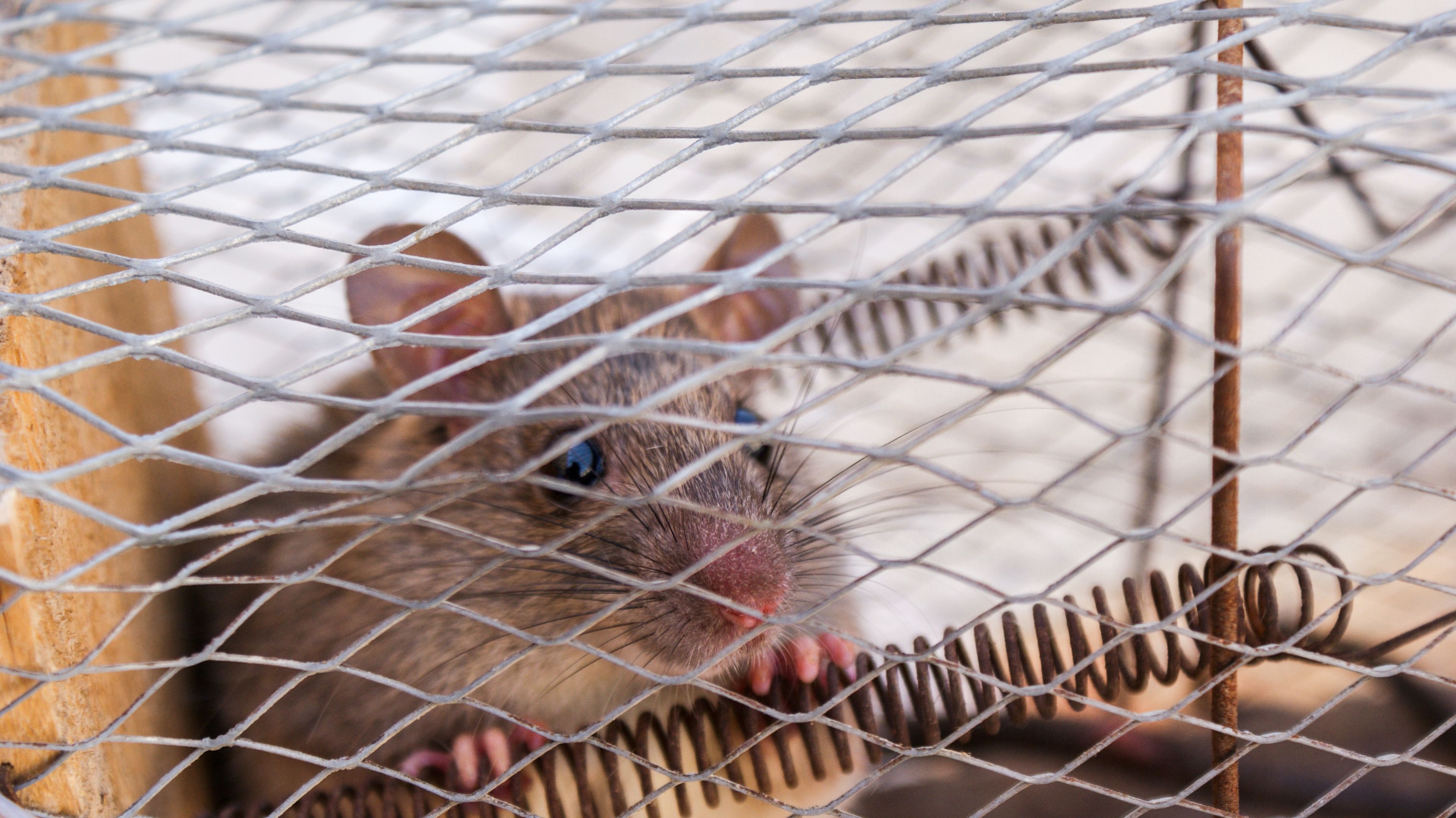Are you hearing scratching and scurrying around your apartment at night? If you don’t have a cat to confirm your suspicions, you may need to look around for signs that you’re sharing your apartment with an unwelcome furry little friend. Rodent problems are common in big cities, especially in New York apartments, given that most apartments in New York are older multi-unit buildings. Regardless of where you live, if you’ve seen droppings, found bite marks on walls or baseboards, or just have an uneasy feeling you’re not alone, you may have a mouse infestation in your apartment, and it’s time you get rid of them.

Take these four steps to get rid of mice in your apartment
Step 1: Notify your landlord that you suspect mice
Your first call if you suspect a mouse problem is to call your landlord, who may already have a preferred exterminator who can get them out ASAP. If not, your property manager may come over and place snap traps or live traps to see if they’ll take care of the problem or contact a nearby rodent control service. It is part of the landlord’s responsibility to keep the apartment clean and safe for you as a tenant, this includes keeping it pest-free.
Step 2: Find how mice got into your apartment
Before the exterminator or landlord arrives, do your best to determine how the mice got into your apartment in the first place. Speedy’s Pest Solutions, a pest management service located in Fresno, California, points out that mice are more prevalent in apartment complexes. Specifically, “It is possible for mice populations to increase in an apartment for several reasons, including exposure to large garbage containers located nearby the building complex, and apartments located between suburbs and rural areas adjacent to fields or empty lots that provide excellent breeding and nesting grounds for birds.” A young mouse can fit through a hole ½ inch wide, and an adult only needs ⅔ of an inch wide hole to enter your apartment. Take the time to search for entry signs and remedy them to prevent more mice from joining the party. Mice like to travel along one path once they have a mouse trail established, making it a little easier to follow their tracks.

Common signs of a mouse in your apartment
Droppings: Mouse droppings look like brown-black grains of rice. They are typically only 1/4 inches in length and pointed on the ends. If you suspect you have mice but have not found droppings, PURCOR Pest Solutions recommends looking for droppings and urine close to where you store food. Be sure to also look in drawers and behind cabinets. “You might also spot bite marks or holes in plastic boxes, cardboard boxes, or baseboards. Sometimes you can even see oily track marks where they’ve traveled between their nest and a source of food.” If you suspect you have mice but have not found droppings, look in all the places mice hide: under furniture, behind kitchen cabinets and appliances, inside cabinets and drawers, in closets, and around the trash. Be careful not to touch them with bare hands. Mouse droppings are toxic and carry pathogens for over 30 different illnesses and diseases, including hantavirus, which can be fatal. Use gloves, a mask, and a broom when cleaning up mouse droppings. Don’t use a vacuum or mop as you don’t want the droppings lingering in your cleaning tools.
Bite marks: Look for bite marks on the inside cabinets, baseboards, walls, food boxes, clothing, and linens, especially if left on the floor which all can be signs of a rodent infestation.
Odors: Mice are not particular about their cleanliness and use the whole mouse trail as a bathroom. If you notice a strange odor, try to find the source. Mouse urine has an ammonia-like smell that you may overlook initially, but if you have a pet they may smell it right away.
Noises: Mice are primarily active at night, and you are more likely to hear them after the sun goes down. They could be scratching and scurrying around during the day, but you are less likely to hear them due to other ambient noises. Try to follow the noise to a particular resting spot so you’ll know where to place traps.
Nests: Mice build nests from various materials they can cut with their sharp teeth. You may have found a mouse nest if you notice a strange lump of cotton or other balled-up materials. They could hide the nest among clothing, towels, sheets, and other fabrics left on the floor for extended periods. City Best Pest Control provides a helpful tip to avoid giving mice areas where they feel that they can nest inside. Removing clutter is one way to avoid nesting in your home.
Tracks: If you suspect you have mice but have found no hard evidence, try dusting flour, talcum powder, or another refined powder in the area where you heard a noise, smelled an odor, or saw other possible signs of a mouse. They will track the powder on their paws, leaving a path to their nest.
Common entry points for mice
If you find evidence of mice in your apartment, you need to remedy any possible entry point so that it doesn’t happen again. Of course, get your landlord’s approval before making any repairs. Here’s how to prevent mouse entry:
Fill cracks and patch holes: Use spray foam to seal up any cracks or holes larger than ½ inch. For areas where mice have chewed away sections of drywall, patch it with steel or copper wool (they can’t chew through it) and caulk it with the same caulking you would use around windows and doors.
Seal entryways and windows: If mice can enter through your window screens, use screen patching tape to cover the hole or replace the whole screen. You can seal doorways or entryways with a piece of rubber trim or a door sweep attached to the exterior bottom of your door. Install screens in all exterior doorways and windows, as these are your most common entry points for tiny creatures.

Step 3: Prevent mice by cleaning your apartment
Cleaning your apartment regularly and storing your food correctly makes the best strategy for preventing mice from entering your apartment.
Eliminate things that attract mice: Mice always look for food, water, or shelter. The biggest driver is food – and since mice are omnivores, anything from last night’s pizza to open food containers in your trashcan is fair game. Put away leftovers and clean up spilled food from your floors and counters to prevent a mouse infestation. Try to not leave dirty dishes in the sink overnight. Pet food left out overnight typically attracts mice. Make sure you thoroughly clean your animal’s food preparation surfaces when it’s not being used. Pest & Pollinator proposes that apartment owners avoid leaving out pet food overnight. “Pet food left out overnight is a favorite snack for marauding mice, who carry kibbles back to their nest to store for later. Mice with a consistent source of food like pet food, crumbs, or even bird seed are less likely to go into traps of any kind.”
Store food properly: If you think an unopened cereal box in a closed cabinet is safe, think again. Store food in heavy plastic or glass containers, as mice will chew through anything they can, including cardboard and simple plastic wrappings. If they find something tasty inside, they are more likely to create a large hole for their buddies to share.
Cover garbage cans: Mice will climb into trash cans, so keep any garbage cans inside your apartment closed with a secure, airtight cover to prevent them from finding a way inside.
Minimize clutter: Keep clothes, blankets, sheets, towels, and any fabric off the floor and countertops. This will prevent mice from using them as bedding or hiding inside.
Fill gaps: If you find gaps around doors or window frames, along baseboards, or inside closets and cabinets, fill them with steel or aluminum wool and caulk it into place. You can also use non-toxic spray foam to fill the gaps.
Use natural repellents: Mice are repelled by the strong smell of peppermint essential oil. Apply it to cotton balls and place them outside your doorways, window sills, or in any gaps you find. Note that this only helps prevent more mice from entering and does not get rid of any ones already inside.
Put a cat on the case: If you have a cat, put that mouser to work. It may take a few days, primarily if your cat hasn’t hunted in a while, but the instinct will return. Cats love to present their owners with gifts or evidence of a job well done, so don’t be surprised if they bring a mouse to you, dead or alive.

Step 4: Set up traps, bait, or mouse poison
Traps and bait can be effective, and there are different types to choose from.
Snap traps: These traps are the ones most people think of when it comes to mouse traps. Snap traps have a wire bar held down by a pin, which gets released when the mouse steps on the lever holding the bait. Then the bar snaps down on the mouse and delivers a fatal blow. Use bait such as dried fruit, bacon, peanut butter, or oatmeal to tempt mice to the trap.
Glue traps: Glue traps work the same way flypaper does. They come in the form of small cards or plastic containers with an adhesive surface that traps the mouse. Adult mice tend to avoid the glue traps. Simply bait the trap and wait for the mouse to go for the bait. The mouse will then get stuck in the glue trap. Glue traps are live traps but are challenging to remove the mice to set free. Crosstown Pest Control says, “ Keeping a simple wooden snap trap under sinks or in the pantry is a great way to be alerted when mice do move in.”
Poison: Poison is one of the most common ways to eliminate mice. If you feel this is a risk you’re willing to take, wear gloves and protective clothing when using any poison. Renters should not tackle chemical mouse extermination on their own, leave that to the professionals with the hazmat suits and move on to the things you can do to rid your apartment of mice.
Where to place the traps properly to prevent hazards
The best place for a snap trap is in a location only accessible by the mice. According to mouse trap manufacturer Victor®, bait and trigger traps should be placed facing toward the wall so mice are lured to them more easily. They also recommend placing traps in cramped areas where mice typically like to hide like behind cabinets and under the stove.
Don’t make these mistakes when placing your traps:
- Not placing enough traps: You should place a trap every two to three feet for the best results.
- Not enough bait: If you do not have enough bait in the trap, the mice will not spend enough time in the trap to get caught. Use a lot of bait to keep them interested.
- Not using gloves: When you take the trap from the packaging and place your bait, use gloves. Mice are wary of human scent, and touching the trap and bait will warn them to stay away.

Looking to save money on your mortgage?
Renovating your home?
Find out what your home's worth, edit facts, and see the impact of home projects.
How to get rid of mice in your apartment with natural remedies
Renovating your home?
If the traps, bait, and poisons give you the chills, there are non-toxic options to get rid of mice naturally in your apartment.
Try these natural mouse repellents.
- Done Right Pest Solutions recommends, “repelling mice naturally with strong-smelling items like peppermint oil or lavender.” Place cotton balls soaked with a strong essential oil like peppermint oil, citronella, lemon, balsam, fir, or eucalyptus, around your apartment. This option isn’t recommended if you have pets, since they will not like smell either.
- Mix one of the essential oils above with rubbing alcohol in a spray bottle. Then spray the mixture around windows, doorways, and any cracks or holes to prevent mice.
- Ultrasonic mouse repellents use high-frequency sound waves above 20,000 hertz to deter mice. People can’t usually hear these soundwaves as the average hearing range of humans is 20 to 20,000 hertz. You can buy a type that you can plug into your electrical outlets or stand-alone models that use vibration to repel mice.
- Keeping your apartment clean will go a long way toward ridding your apartment of mice. Vacuum floors, mop up spilled food, and keep floors and countertops clear of clothing, backpacks, or other bulky things, so mice have no extra items to hide behind or inside.
- Air-tight, heavy-duty containers keep your food safe from mice by preventing them from gnawing through cardboard boxes or flimsy packaging.
- If you can deal with a live-trapped mouse, a humane mouse trap might work. This is a small box called a bait station, usually made of wire, where you place bait like peanut butter, cheese, oatmeal, dried fruit, or bacon. Place the bait inside on a lever; the trap’s door will come down when the mouse goes for the bait, trapping it inside. Take the trapped mouse to a park or field and release it.
Mice are never welcome as guests in an apartment as they can cause a great deal of damage. Unfortunately, dealing with them can be unpleasant. If you have to take on the task, know you have a range of methods to deploy – just be sure to inform your landlord of any rodent problem as soon as you know about them.



























 United States
United States Canada
Canada